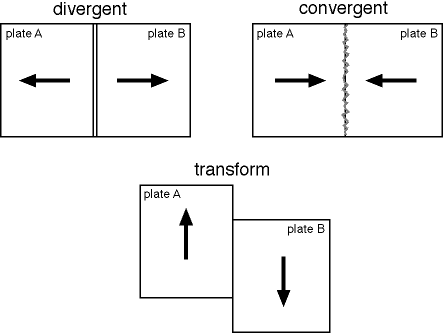
The Earth's outermost layers (the lithosphere) are broken into about a dozen or so plates. These thin, wide tectonic plates move around on the globe independent of one another. Most volcanoes and earthquakes are concentrated near the boundaries between plates. At the boundary between two plates there are three possible types of motion along that boundary:
Divergent boundaries are where plates are moving apart. The result is either a midocean ridge (eg., Mid Atlantic Ridge) or a continental rift zone (eg., East African Rift). Normal faults form in divergent zones.
Convergent boundaries are where plates are moving toward one another. If one or both of the converging plates are thin, mafic oceanic crust then a subduction zone results such as around the Mariannas Trench and the Peru Chile Trench. If both plates are thick, felsic continental crust then the result is a continent-continent collision and major mountain belt such as the Himalayan Mountains. Thrust and reverse faults, folds, and metamorphic foliations form in zones of convergence.
Transform boundaries are where plates
are moving side by side. Midocean ridge spreading centers are offset
by many transform faults. There are a number of major
continental transform boundaries such as the San
Andreas fault. Numerous large and small strike-slip faults are found
in California throughout the Pacific-North America transform plate
boundary region.
